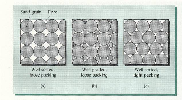|
|
Bulk density
-
The bulk density (BD) expresses the quotient of weight per
volume of soil, i.e the mass of oven dry soil (gram) per total volume of soil
(cm3).
-
The bulk density takes into account the total soil volume (the
space occupied by the solid particles plus the space occupied by the air of the
pores or pore space).
Factors affecting BD:
-
texture
-
grain size
distribution
-
Soils with a high proportion of pore space to solids have lower
BDs than those that are more compact and have less pore space, hence any factor
that influences pore space will affect BD.
i) texture
-
Fine-textured soils have lower BD than do sandy soils. The
solid particles of the fine-textured soils tend to be organized in porous
granules, especially if soil organic matter (SOM) is present. In these
aggregated soils pores exist between and within the granules and ensures high
total pore space and a low BD.
 |
| Fig.1 Clayey aggregates and coarse sand
grains |
| (
Source: Brady and Weil 2002.) |
-
In coarse textured sandy soils, the SOM generally is low. The
solid particles are less likely to be aggregated and the BDs are commonly
higher as they have only few of the fine, within ped pores (less
porosity).
ii) grain size distribution
-
Loosely packed grains may fill as little as 25 % of the bulk
volume (a. in fig.2).
 |
| Fig.2 Sand grain and pores |
| (
Source: Brady and Weil 2002.) |
-
Tightly packed grains may fill as much as 75 % of the
volume.
-
If sand particles are mostly of one size class (well-sorted
sand) the BD is generally lower. If a mixture of different sizes (well graded
sand) is present, the BDs are higher.
|
|

 previous | next
previous | next